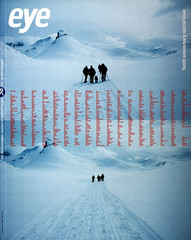Winter 2000
Blank Generation
The glossy enigma of digital supergirls. Critique by Rick Poynor
The model is lying on an overturned supermarket trolley. Her dresses - she’s wearing two, paint-splattered and sprayed - trail among the rubbish on the ground. Behind her, through the trolley’s frame, you can see an unsightly carpet of trash.
A distant lorry is bringing more waste to the dump. Gulls on the lookout for scraps glide overhead. Pop, in which this image appears, is a new magazine from the publishers of The Face. It’s devoted, according to the cover, to ‘Super Fashion, Shiny Art’ - and that sums up its worldview. Pop is a very ‘now’ kind of product. It’s hugely confident, totally convinced of its own glossy rightness, but artily vague about its purpose or point. Probably it prefers ‘enigmas’ - the word comes up twice on its contents page alone.
In Pop, editorial and advertising are as tightly entwined as models at a fashion shoot. It’s not easy to prise them apart and that’s the way they - and no doubt their advertisers - like it. Pop showcases the work of digital lensmen such as Mert Alas and Marcus Piggott (who shot the dump), Sølve Sundsbø and Norbert Schoerner, who is also profiled in the issue. ‘Is he a commercial photographer or an artist working in photography?’ asks Pop. Schoerner professes not to know; it’s something to do with developing his full potential, apparently.
For the past two or three years, digital photography has been all the rage in fashion circles grown weary of grungy verité. Work by Pop’s photographers and others can be seen in The Impossible Image (Phaidon). In the introduction, Vogue art director Robin Derrick enthuses about how new and exciting it all is, but offers no insights into what these ‘extraordinary mind-games’ might mean. The motivation of male fashion photographers has always been a bit suspect - all those beautiful women at your service, all those bodies to scope out. How much creepier to imagine them tweaking their digital playthings pixel by pixel into an ‘image of impossible perfection’ (Derrick).
Actually, we have been here before. Some of Sundsbø’s Pop images are so sleek, so purged of specific surface detail, so polished until they shine with all the radiance of plastic, that they might have been confected in the early 1970s with an airbrush. And only an art director who has forgotten, or somehow missed, early Dali could describe the molten forms and trite dislocations of digital fashion imaging as offering ‘new languages and conventions’ (Derrick, again).
What does feel new in these pictures is the blankness of many of the models, who bear more resemblance to animatronic dolls than living beings. Artificiality may be the very essence of fashion photography, but here, the lust for epidermal perfection propels the images towards a mass-market embrace of concepts of the ‘post-human’ that were first broached in early 1990s art and critical theory. What does it mean, as a viewer and buyer of fashion, to want to identify with a fantasy figure who is inert, pliable, glacial - not really there?
One thing’s for sure: the move from optical to digital imaging is fundamentally rewriting the viewer’s contract with the image. If Alas and Piggot had taken a couple of models to a real dump to shoot their pages in Pop, a significant part of the meaning would have come from our understanding that everyone had made an investment of time and energy, and put up with the discomfort and smells. As constructed with the computer, in conditions of sterile detachment, these montages are merely frivolous. They lack presence and weight. The dump doesn’t feature because it signifies anything, or relates in a critical way to the subject. It is nothing more than a ‘look’.
This might imply that such pictures, shot differently, could have had something significant to say about fashion. This is debatable, to say the least. The key question that’s sidestepped in The Impossible Image - where pictures are plucked from their original contexts and presented as art - and in Pop’s interview with Schoerner, is the extent to which it is really possible to speak independently, let alone critically, in publications that exist expressly to promote fashion. On the evidence of Pop, ‘super fashion’, with a big helping hand from ‘slick ads’, could prove to be the undoing of ‘shiny art’.
Rick Poynor, writer, founding editor of Eye, London
First published in Eye no. 38 vol. 10, 2000
Eye is the world’s most beautiful and collectable graphic design journal, published quarterly for professional designers, students and anyone interested in critical, informed writing about graphic design and visual culture. It is available from all good design bookshops and online at the Eye shop, where you can buy subscriptions and single issues.

